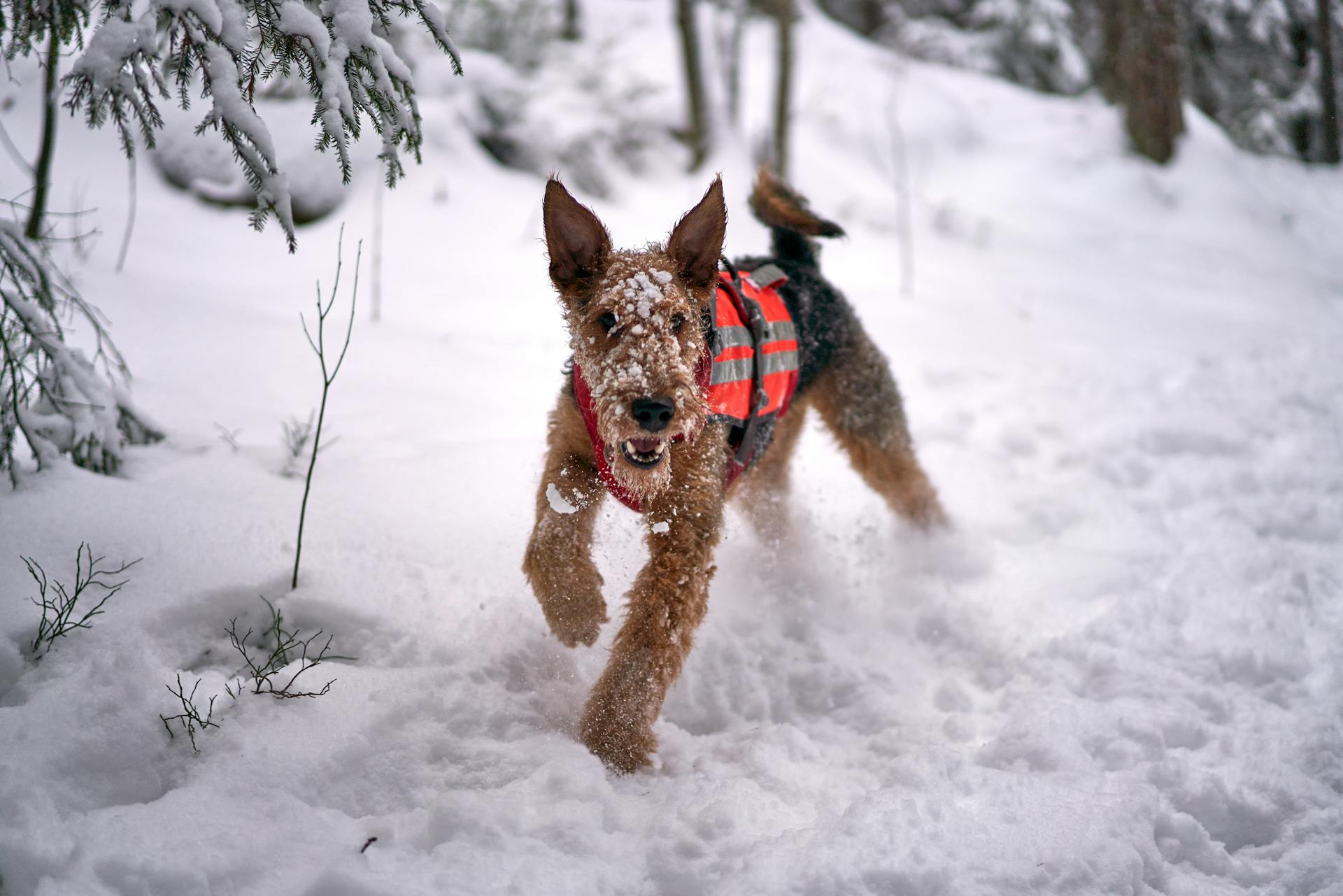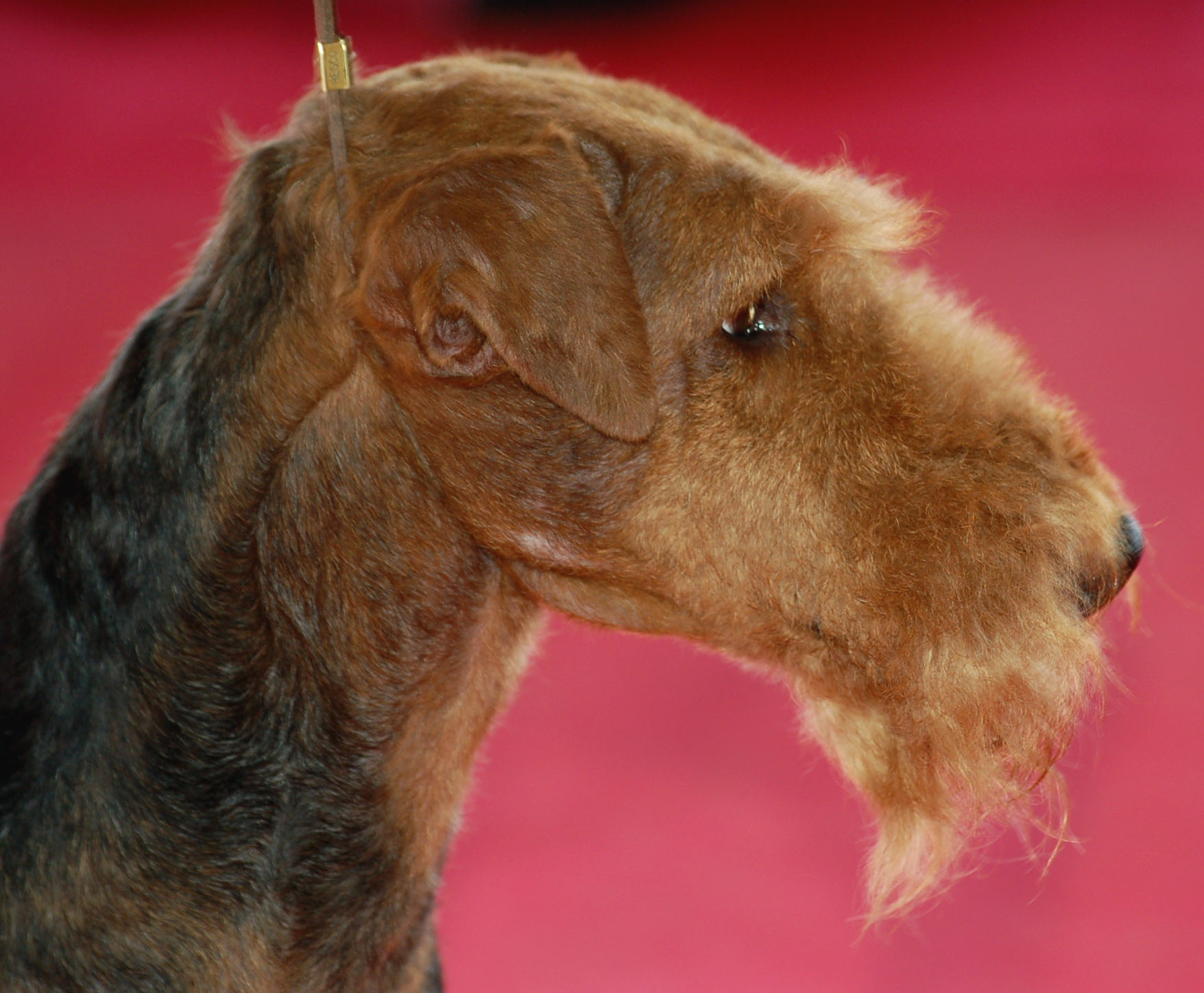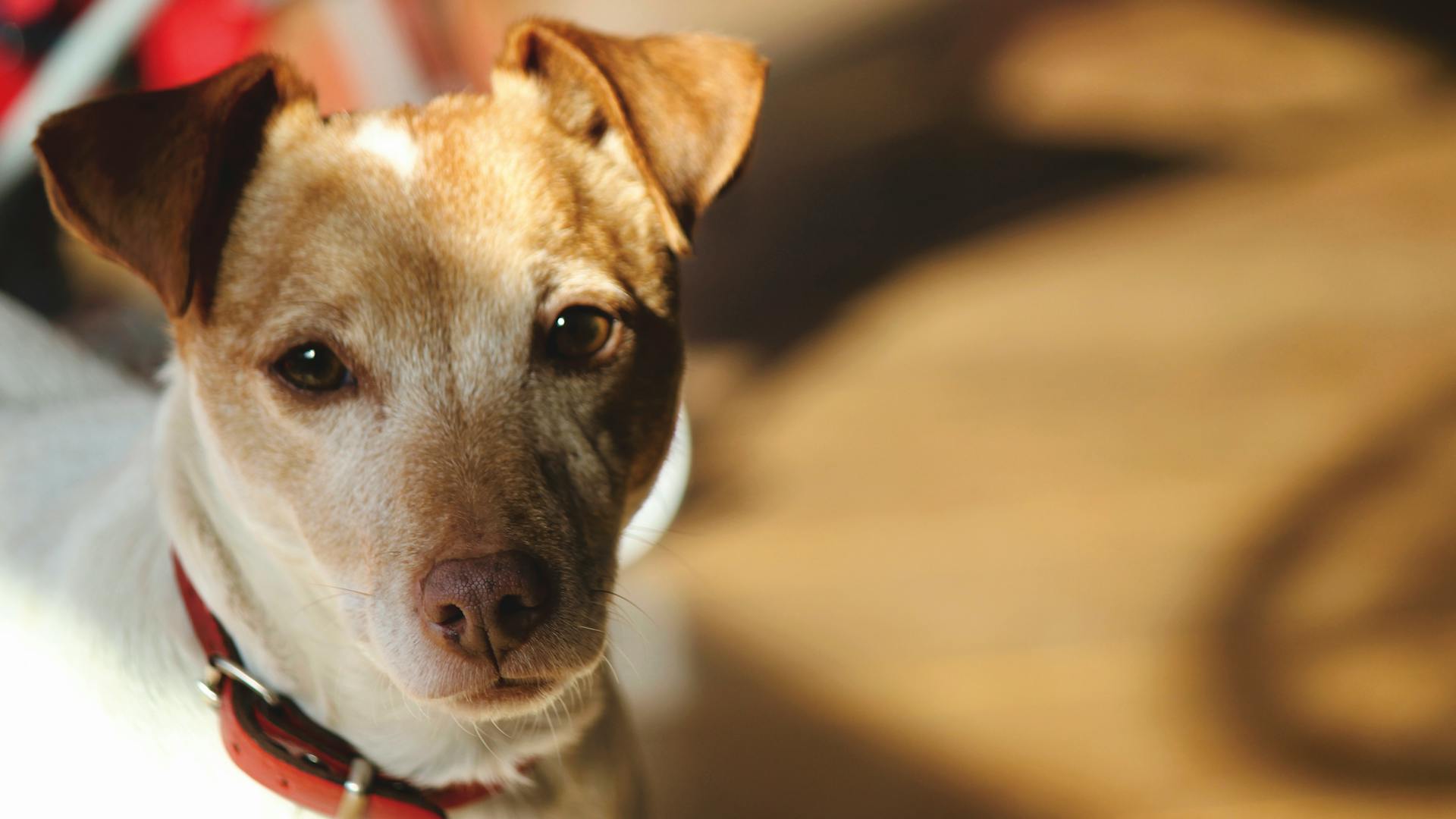
The Airedale Terrier is a breed built for adventure, with a rich history in hunting and tracking.
Their strong prey drive and keen sense of smell make them a valuable asset on the hunt.
Originally bred in the 19th century to hunt otters, the Airedale Terrier's fearless and energetic nature made them a natural fit for the task.
Their athletic build and agility allow them to navigate challenging terrain with ease.
In the field, Airedale Terriers are known for their ability to follow a scent trail for hours, making them a favorite among hunters.
Check this out: Hunt Terrier
Hunting Style
The Airedale Terrier's hunting style is a unique blend of characteristics that make them a valuable asset in the field. They're more of a flushing retriever than a spaniel, despite not being born with the quartering instincts of a bred flusher.
Airedales cover ground with ease, though they tend to hunt in closer quarters than a typical ranging pointer. Their methodical and brave approach to hunting makes them a joy to watch.
Their retrieving instincts are top-notch, and they'll pursue anything from small creatures to tennis balls with vigor. Prey instincts are high in the terrier class, and the trained Airedale proves excellent at marking, searching for, and bringing birds to hand.
Folks who hunt with Airedales refer to themselves as "Airedalers", and their dedication to the breed is impressive. They've earned the right to compete in AKC Spaniel Tests since 2009.
Grooming
Airedales require professional grooming every two to three months to look their best and keep their wiry coat manageable.
Brushing once or twice weekly is all that's required for the light-shedding breed.
They should be bathed only when they become dirty, as frequent bathing makes the wire coat overly soft.
Check your Airedale's ears once a week for signs of infection, and clean them with a gentle cleanser to avoid wax and dirt buildup.
Clip his toenails about once per month to avoid breakage.
Airedales bearing undercoats are generally groomed by hand stripping, which involves using a small serrated edged knife to pull out loose hair from the dog's coat.
Most Airedales require frequent clipping or stripping as they do not shed.
The AKC breed standard emphasizes the importance of maintaining the correct coat color, which is either a black saddle with a tan head, ears, and legs, or a dark grizzle saddle.
Training and Temperament
Airedale terriers are highly intelligent and trainable dogs, but they can be stubborn if not treated right. They respond well to positive reinforcement and rewards, and they love to please their owners.
Airedales are a very playful breed, but they also get bored easily, so training should be varied and challenging to keep them engaged. They won't respond well to repetitive, simple drills.
Training an Airedale from a young age is crucial, as they can learn bad habits early on and it's hard to break them out of those habits later. Consistency and patience are key when training an Airedale.
Airedales are naturally energetic and require active training sessions that engage them mentally. They have the stamina for long training sessions, as long as the training is engaging.
Airedales have strong instincts for digging, chasing, and barking, which can be difficult for first-time dog owners to manage. They require patient and consistent training to stave off boredom.
With proper training, Airedales can be loyal and loving companions, and they're excellent choices for active families. They can also be used as working dogs and hunting dogs, and they have a natural ability to herd and chase animals.
Physical Characteristics
The Airedale Terrier is a sturdy breed with a unique set of physical characteristics that make them well-suited for hunting.
They typically weigh between 50-80 pounds, with some larger individuals reaching up to 100 pounds in the Oorang strain.
Their weight can vary depending on the breeder and the specific bloodline, but 50 pounds is a common and healthy weight for a mature Airedale.
The Airedale's tail is a distinctive feature, traditionally long and erect, but it can be docked in some parts of the world.
Appearance
The Airedale is the largest of the British terriers, weighing 19-25 kilograms in fit condition and standing 58-61 centimeters tall at the withers for males.
Females are slightly smaller than males.
The American Kennel Club standard specifies a very slightly smaller dog.
Larger Airedales, up to 55 kilograms, can sometimes be found in North America.
These larger dogs are sometimes referred to as "Oorangs" due to their association with a kennel in Ohio in the early 1900s.
Their medium-length black and tan coat features a harsh topcoat and a soft undercoat.
You might enjoy: American Kennel Club Lancashire Heeler
Size
Airedales typically weigh between 50-80 pounds, making them active and agile enough to perform well, while also serving as a physical deterrent.
Their weight can vary depending on the breeder and bloodline, with some Airedales weighing as much as 100 pounds.
The Oorang strain, developed in the 1920s, produced Airedales that weighed between 60-100 pounds, with some females weighing slightly less.
In the United States, male Airedales typically weigh between 40-70 pounds, while the Oorang strain can weigh between 80-120 pounds.
Airedales stand between 22-24 inches at the shoulder, with the Oorang strain being slightly taller on average.
A fresh viewpoint: Bull Terrier Then and Now
Tail
The Airedale's tail is a distinctive feature of the breed. It should be carried gaily but not curled over the back, according to the official AKC standard.
In most European countries and Australia, it's illegal to dock dogs' tails unless it's for the dog's benefit. This has led to the emergence of a spitz tail in some dogs.
The root of the tail should be set well up on the back, and it should be of good strength and substance.
Related reading: Straight Back German Shepherds
AKC and Certification
The American Kennel Club (AKC) has a long history with Airedale Terriers, and it's a story of perseverance and determination. They were originally brought up to be hunting dogs, but it took a while for the AKC to recognize them as such.
Airedales gained a 'jack of all trades, master of none' reputation in hunting circles when they were first introduced to America in the early 1900s. This was partly because they were used mostly by countryfolk for practical reasons, rather than being bred specifically for hunting.
The Airedale Terrier Club of America spent years requesting that the competitions they ran with their Airedales be recognized as legitimate. The AKC finally relented in 2009, allowing Airedales to compete in spaniel contests.
This means that Airedales can now attain hunting titles, and it should lead to wider recognition of their use as a legitimate gun dog. The AKC's recognition of Airedales as hunting dogs is a significant milestone in the breed's history.
Hunting and Activity
Airedale terriers are excellent running partners who will cover up to five miles or more by your side. They also have the stamina for long hikes, but their instinct to chase everything that crosses the trail may make hiking an exercise in frustration.
Their hunting style is methodical and brave, making them well-suited for flushing and retrieving game. They cover ground with ease, though in closer quarters than a typical ranging pointer.
Airedales are natural retrievers and can be trained to mark, search for, and bring birds to hand. They're excellent at identifying likely spots that birds would be hiding, and they show little hesitation in penetrating thick cover to retrieve a bird.
Here are some key characteristics of Airedale terriers in different hunting contexts:
- Upland game: Airedales are excellent at flushing and retrieving birds, and they can cover the area well.
- Waterfowl: Airedales are generally comfortable in water and can swim out to retrieve birds, but some may be more hesitant than others.
Their dense coat requires regular grooming and clipping, but it also helps to insulate them against cold water during hunting season.
Upland Game
Upland Game hunting involves pursuing non-water birds like quail or pheasants, which tend to be found on the ground in areas of heavy cover.
Airedales excel in this task, especially since they were originally trained to flush bears out of their dens. Some Airedales will perform a hard flush, charging right in and forcing the birds to take flight, while others take a more patient approach.
Airedales are also excellent at retrieving, and they show little hesitation in penetrating thick cover to get the bird. They're smart enough to understand the importance of handling their prey with care.
Their thick, wiry coat insulates them against cold waters, allowing them to swim out to retrieve your bird no matter how large or cold the body of water is. Airedales tend to approach water retrievals critically, trying to find the most effective way to access the bird.
Readers also liked: Bernese Mountain Dog Cold Weather
Big Game

Big game hunting often involves a pack of dogs, and some hunters still bring Airedales along for their unique qualities. Airedales bring grit, intelligence, and determination to the hunt.
Their fearlessness can be a major factor in encouraging game to tree themselves. This makes hunting easier and safer for the hunters.
Some old-school big game hunters swear by Airedales, despite their replacement by hounds and pointers in modern hunting circles.
Expand your knowledge: Game Bred American Pit Bull Terrier
Activity Distance Rating
If you're an avid runner, you'll be happy to know that Airedales make excellent running partners, capable of keeping up with you for five miles or more.
Their stamina is impressive, but it's worth noting that they can get distracted by their surroundings, which may make running a bit more challenging than expected.
Airedales have the endurance for long hikes, but their strong prey drive can make hiking an exercise in frustration. They'll chase after anything that crosses their path, whether it's a squirrel or a rabbit.
To make the most of your hiking experience with an Airedale, be prepared for a wild ride and consider keeping them on a leash to avoid any potential distractions.
Here's a summary of their activity distance rating:
Frequently Asked Questions
Do Airedale Terriers have a high prey drive?
Airedale Terriers have a strong prey drive, making them less suitable for households with small pets. This instinct can be managed with proper training and socialization.
Were Airedales used to hunt bears?
Airedales were indeed used in bear hunts in the western US, where they would play a crucial role in protecting hounds from bears. Their unique "cat and mouse" tactics allowed them to outsmart bears and keep hounds safe.
Featured Images: pexels.com

